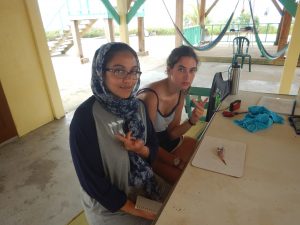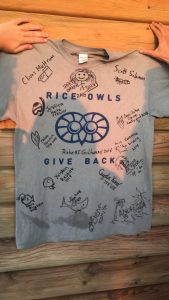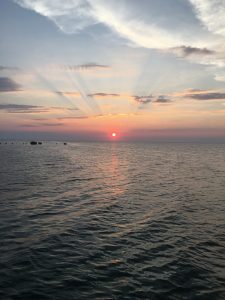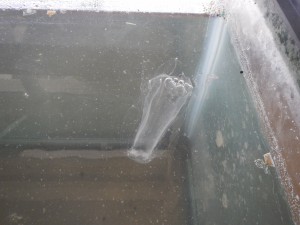This morning, we started the day by riding the boat out to the nearby Smithsonian Tropical Research Institute, which is situated on a teensy neighboring island called Carrie Bow Island. We got a short tour by Clyde, one of the managers, and received a short talk from a professor working on coral research at the station.
She showed us her rows of tanks of baby corals that she’s been growing as part of an experiment. A hybrid between to species of coral has recently emerged and appears to have increased resistance to high water temperatures. She is studying this coral to elucidate the mechanisms behind this heat resistance. If she succeeds, it could mean worlds for the future of coral reefs.
It was incredibly inspiring to see how determined researchers head the fight for the survival of coral reefs.
Our last stop before returning the airport was the mangroves of Twin Caye. Snorkeling here was not at all like snorkeling at the reefs. Mangroves are a type of tree that can grow in salty or brackish water. They have characteristic prop roots that reach far down into the water so that the rest of the tree stands above the water.
The roots of these trees provide a vital habitat and nursery to many species of sponges, fish, algae, and some Echinoderms, as well as many others. Water here was murkier than at the coral reefs because the sea floor is covered in silt and decomposing mangrove leaves.
It seemed that every inch of available space on the roots was colonized by something or the other. Bright orange fire sponges encrusted much of the tree roots, and all forms of algae grew everywhere. Schools of baby fish undulated as if they were a single entity, flowing between vegetation.
We didn’t get to see any urchins here, but we did find two large unidentified sea stars on the sea floor. They were heavier, had more slender arms and spinier skin than the cushion stars I’d seen before. They were bright, fiery orange, and a lot larger than I expected starfish to be – easily twice the size of my hand! After examining them closely and snapping some pictures, I let them drift back down to the silt bottom where we’d found them.
 Here’s on of the starfish we found!
Here’s on of the starfish we found!
We weren’t given a chance to shower before we re-entered human civilization (thanks a lot, Scott and Adrienne! I’ll bet the people sitting next to me on the plane really appreciated that LOL). After eating at a restaurant on the dock of Belize City, we headed to the airport to go home.
You guys!! There was AIR CONDITIONING at the airport!! WOW!! And there were OTHER HUMANS who were not TFBs or encrusted with a solid layer of Eau de Wilderness™! IncREdiBLE!! When the surprisingly short flight to Houston landed at Hobby Airport, I experienced the oddest sensation of emerging from a separate world back into the familiar concrete jungle of bustling human traffic.
And really, my time in Belize has been an absolute dream. Now that I’m sitting in a cushy bed in an air-conditioned building and without moisture clinging to my every pore, I feel like I’ve been living a different life for the past two weeks. The culture shock is so real.
I don’t think it’s hit me yet that it’s over. I half believe that tomorrow morning, I’ll wake up and head out on a boat again to sea. Some time in the next few days, I’ll be posting a reflection about this trip. Honestly, right now, I don’t know where to begin – all I’m feeling is that I wish I were still in Belize – but stay tuned while I gather my brains for one last word dump!












 Here’s on of the starfish we found!
Here’s on of the starfish we found!

